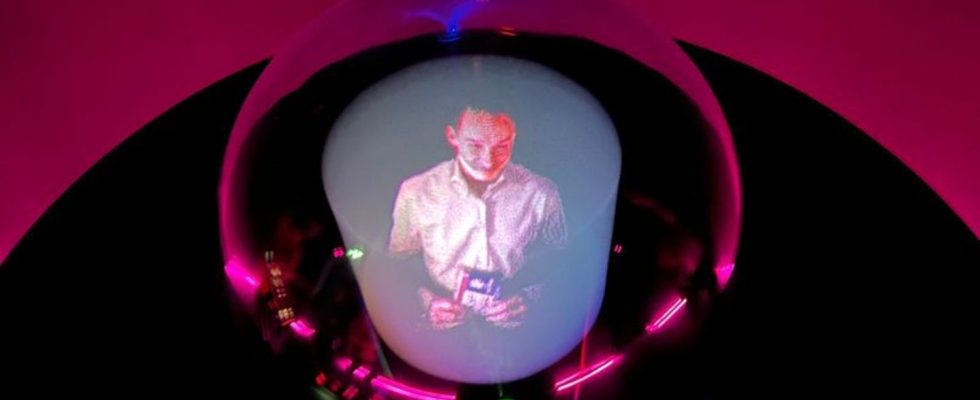Mobile communications trade fair MWC
Looking into the crystal ball: Advances in hologram telephony
At the Mobile World Congress in Barcelona, Telekom is presenting a router with a glass ball that is intended to enable hologram telephony. photo
© Wolf von Dewitz/dpa
Corona is long over, but working from home is still widespread. So that colleagues can still give each other good advice, so-called hologram telephony could help. There is progress.
The market launch of three-dimensional hologram telephony for end consumers is getting closer. The software company Matsuko announced at the MWC mobile phone trade fair in Barcelona that it has started selling a product to companies that… 3D experience significantly improved. “It has been available since today,” said the head of the Slovak company, Maria Vircikova. It is necessary to wear virtual reality glasses; the user can see the holograms in these glasses. One of the first customers for the new product presented at the trade fair is the Bielefeld construction company Goldbeck.
In video conferences transmitted using Matsuko software, only one person could previously be seen as a three-dimensional image – usually the central speaker, whom the listeners saw in their virtual reality glasses. When these listeners said something themselves, they did not appear as a 3D image. That’s changing now. In addition, a virtual model can appear between them – such as a house that is yet to be built or a machine that needs to be improved. It can be helpful for architects, engineers or designers to see the object in front of them and talk about it together.
Private customer market launch targeted for 2026
It will take some time before holography becomes a mass market for private customers. The Spanish telecommunications provider Telefónica with its German subsidiary O2 is aiming for a market launch in 2026. Then O2 customers could see the people they are talking to in three dimensions – provided they wear VR glasses. It is still unclear what this could cost for private customers. However, it is conceivable that customers book an additional option in their tariff and then have access to the technology.
The telecommunications industry has great expectations for this new type of communication. “It’s becoming more natural,” says Telefónica developer David Moro. The 3D view brought the conversation partners closer to each other. “The better they can reveal their emotions, the better the communication.” Moro emphasizes that the network operator Telefónica is technically ready to introduce holography for private individuals. However, so far too few people have compatible VR glasses for this technology to be used on a large scale. “According to our forecast, it will take another two to three years until the mass market is there.” The providers of VR glasses include Apple and Meta.
Up to ten times more data
If 3D phone calls were actually used by the general public in the following years, this would pose challenges for network operators. According to Moro, a hologram phone call requires five to ten times as much data as a normal video call without the 3D effect. The network operators still expect a lot from the new technology; after all, their transmission networks could then become even more important than they already are in the digital age.
Matsuko isn’t the only developer of holography software. But he has a central role to play, after all he works with several network operators. The new product presented on Tuesday could be a milestone in establishing the technology.
Artificial intelligence from the chip manufacturer Nvidia is also used. Thanks to this AI, the participants see the conversation partners without VR glasses, even though they are wearing the glasses. This is possible because they filmed each other briefly beforehand. The AI then adds the eye area to the 3D image, which is covered by the VR glasses during the meeting. This makes it appear as if the participants in the conversation are making eye contact. During the video call, you must have your smartphone in front of you, whose camera will film you.
Telekom has a holographic router
Directly next to the Telefónica trade fair stand where Matsuko presented his progress, Deutsche Telekom has its current location at the industry meeting in Barcelona. One of the Magenta innovations is also about holography: Telekom wants to change the use of routers by giving them additional benefits. As a concept study, the Bonn developers presented how this could happen.
A suggestion: There could be a crystal ball on the router in which the caller appears as a three-dimensional image. In contrast to the Matsuko development, no virtual reality glasses are required for this; the viewer sees the 3D effect with their naked eyes. In Telekom’s router prototype, three lamps shine from below against vibrating high-tech plastic that is in the glass ball and was developed by the company Voxon Photonics. The caller appears as a figure about 20 centimeters tall. It remains to be seen whether such a crystal ball router with a 3D effect will ever become a product and be available for purchase in stores.

